
The Arctiinae are a large and diverse subfamily of moths with around 11,000 species found all over the world, including 6,000 neotropical species. This subfamily includes the groups commonly known as tiger moths, which usually have bright colours, footmen, which are usually much drabber, lichen moths, and wasp moths. Many species have "hairy" caterpillars that are popularly known as woolly bears or woolly worms. The scientific name Arctiinae refers to this hairiness. Some species within the Arctiinae have the word "tussock"' in their common names because they have been misidentified as members of the Lymantriinae subfamily based on the characteristics of the larvae.

The garden tiger moth or great tiger moth is a moth of the family Erebidae. Arctia caja is a northern species found in the US, Canada, and Europe. The moth prefers cold climates with temperate seasonality, as the larvae overwinter, and preferentially chooses host plants that produce pyrrolizidine alkaloids. However, garden tiger moths are generalists, and will pick many different plants to use as larval host plants.
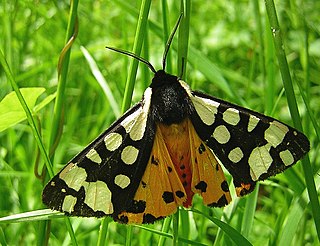
The Arctiina are a subtribe of moths in the family Erebidae.

Arctia is a genus of tiger moths in the family Erebidae. Therein, it belongs to the subtribe Arctiina in the tribe Arctiini in the subfamily Arctiinae. Species are well distributed throughout North America, Palearctic, India, and Sri Lanka.

Arctia menetriesii, the Menetries' tiger moth, is a species of tiger moth in the family Erebidae. It was first described by Eduard Friedrich Eversmann in 1846. It is found in Karelia, Oktyabrskoe, northeastern Kazakhstan, Altai Mountains, Sayan Mountains, Evenkia, Yakutia, the central Amur region, Primorsky Krai and central Sakhalin. It was believed to be extinct in Fennoscandia, but the species has been recently recorded in Finland. This species is characterized by the fact that they never come to light; such behavior is atypical in the family Arctiidae.

Zygaena fausta is a member of the family Zygaenidae, the day-flying burnet moths. Its bright aposematic colours of red, white and black on the wings indicate to possible predators such as birds that it is foul tasting or poisonous. In flight, the bright red abdomen is revealed, contrasting with the white legs and black head and antennae; the thorax is black and white with an eye spot on each side. There appears to be a considerable variation in pattern among specimens from different parts of Europe.

Arctia villica, the cream-spot tiger, is a moth of the family Erebidae. The species was first described by Carl Linnaeus in his 1758 10th edition of Systema Naturae. It is distributed from the Iberian Peninsula, Anatolia, western and northern Iran, western Siberia, southwestern Asia and North Africa.
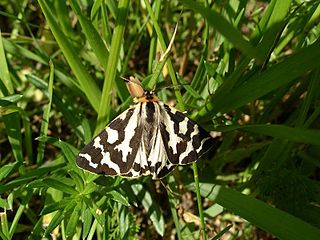
Arctia plantaginis, the wood tiger, is a moth of the family Erebidae. Several subspecies are found in the Holarctic ecozone south to Anatolia, Transcaucasus, northern Iran, Kazakhstan, Mongolia, China, Korea and Japan. One subspecies is endemic to North America.
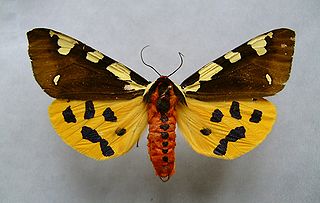
Arctia is species of tiger moth in the family Erebidae. It was first described by Carl Linnaeus in his 1758 10th edition of Systema Naturae. It can be found in central and eastern Europe, Kazakhstan, southern Siberia, northern Mongolia, Amur Region, Primorye, Sakhalin, Kunashir, northern and northeastern China, Korea and Japan.

Arctia virginalis, the Ranchman's tiger moth, is a species of tiger moth in the family Erebidae. It was first described by Jean Baptiste Boisduval in 1852.
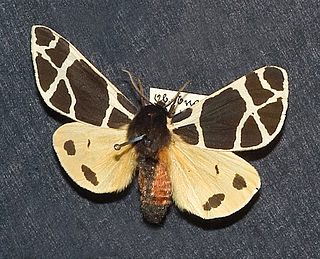
Arctia flavia, the yellow tiger moth, is a moth of the family Erebidae. The species was first described by Johann Kaspar Füssli in 1779. It is found in the Alps above the tree level. It also occurs in Balkan mountains (Rila), European Russia, northern Kazakhstan, Siberia, Mongolia, north-eastern China, and Korea.

Arctia tigrina is a moth of the family Erebidae. It is found on the Iberian Peninsula and the South of France and Italy.

Arctia aulica, the brown tiger moth, is a moth of the family Erebidae. The species was first described by Carl Linnaeus in his 1758 10th edition of Systema Naturae. It is found in the temperate areas of central Europe up to the area surrounding the Amur River to the east and up to the Balkans and the Black Sea to the south.

Diphthera festiva, the hieroglyphic moth, is a species of moth in the family Nolidae and is the only moth in its subfamily Diphtherinae. It is found in the tropical and subtropical areas of South America, Central America, North America, and the Caribbean. In North America, the species has a southeastern distribution from South Carolina west to Texas along the Gulf Coast. Strays have been recorded as far north as Michigan and Missouri. The wingspan is 37–48 mm (1.5–1.9 in). This species is occasionally considered a pest on soybeans. It was described by Johan Christian Fabricius in 1775.

Arctia alpina is a moth of the family Erebidae. It is found in northern Scandinavia, northern Siberia, high mountains of southern Siberia and northern Mongolia; also in Alaska and northwestern Canada.
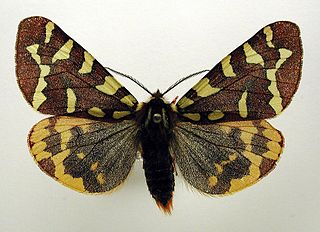
Arctia lapponica is a moth of the family Erebidae first described by Carl Peter Thunberg in 1791. It is found in northern Eurasia and the Arctic part of North America.
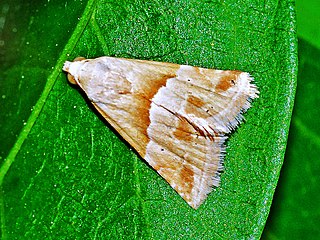
Eublemma parva, the small marbled, is a moth of the family Erebidae. The species was first described by Jacob Hübner in 1808.
Arctia seitzi is a moth of the family Erebidae. It was described by Andreas Bang-Haas in 1910. It is found in central Asia, including Kazakhstan and Kirghizia.

Arctia testudinaria, or Patton's tiger, is a moth of the family Erebidae. It was described by Geoffroy in 1785. It is found from northern Spain to southern and central France and southern Switzerland to north-eastern and southern Italy. It has also been recorded from Great Britain. The habitat consists of grasslands, slopes, forest edges, clear dry forests, cliffs and mountain slopes, maquis, garrigues and dry meadows.
Arctia ornata is a moth in the family Erebidae. It was described by Otto Staudinger in 1896. It is found in the Russian Far East and Mongolia.



















